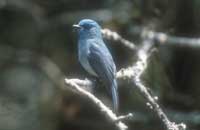
| EMAIL THIS PAGE TO PALS |
Introducing Sri Lanka
by Gehan de Silva Wijeyeratne (eco@jetwing.lk), March 2005 - all images are copyright
(This article is reproduced from a forthcoming guide on
Where to watch Birds and Wildlife in Sri Lanka by Shoebill Publications )
Sri Lanka is a destination with everything. Sun, sea, sandy beaches, cool mountains, ancient stupas and lakes, forests teeming with wildlife, precious stones, magnificent archaeological sites and above all friendly people. Combine this with widely-spoken English and a good tourist infrastructure, and it is easy to see why it continues to be a popular tropical island destination. Snorkeling in the morning can be followed by hill-walking by nightfall, in this compact island.
Physically, Sri Lanka is a tear drop shaped island in the Indian Ocean separated from the Indian peninsula by the Gulf of Mannar and the Palk Strait, which at its narrowest is just 32 km. The island is 432 km from north to south and 224 km from east to west. It is about twice the size of Belgium or a third larger than Switzerland. There are fine sandy beaches around most of the island. The strip from the west coast to the south is developed for tourism. The resorts at Negombo to the north of Colombo, and those to the south at Bentota and Beruwela are magnets for beach lovers and watersports enthusiasts. Further south in Unawatuna and Hikkaduwa are fine beaches with opportunities for snorkeling and diving. Swimmers share the ocean with turtles.
Further south on the coast are the Dutch fortress towns of Galle and Matara and beyond them the sanctuaries of Kalametiya and the national parks of Bundala and Ruhuna (Yala). Here the jungle belongs to Elephants, Leopards and dozens of other large animals that can be seen on safari. Tissamaharama, previously the centre of an ancient kingdom, is now a thriving safari centre. In the harsh dry zone scrub jungles are hermitages where the way of life has changed little for two millennia.
Sri Lanka is often referred to as Buddha's Island, and the country's long association with Buddhism has had an impact on the physical landscape and on the social and political fabric of society. The legacy of ancient cultures is evident in the hundreds of ancient man-made lakes that dot the country, particularly in the dry lowlands. Some have been in continuous use for more than 2,000 years. Many examples of early art are known, from the sublime rock sculptures at the Gal Vihara in Polonnaruwa to the paintings commissioned by the fratricidal King Kasyappa who sought to reconstruct heaven on an isolated rock monolith at Sigiriya. Today, very little survives intact but what does includes the famous frescoes of beautiful maidens.
In Sri Lanka, wildlife and culture are often inseparable and this exciting mix is nowhere more evident than in the ancient capitals of Anuradhapura and Polonnaruwa in the north central plains. Culturally, these ancient kingdoms rival those of the Egyptians, Mayas and Incas, but unlike them, many of Sri Lanka's ancient temples, dating to pre-Christian periods, are still flourishing in a Buddhist and Hindu culture. Anuradhapura and Polonnaruwa form two apices of a cultural triangle. The third, to the south, is the hill capital of Kandy. This became the seat of the Sinhalese kings after successive invasions and internal dissent led to the abandoning of the magnificent capitals in the north central plains. The route south to Kandy from the north central plains runs past the cave temple complex of Dambulla and the Aluvihara in Matale. Unlike the kings, the monks never deserted their monasteries and continued to uphold the monastic traditions, unbroken over several centuries. Dambulla is breathtaking. Cave after cave has its walls covered with ancient paintings and a bewildering array of religious statuary has been constructed by generations of royalty and lay donors.
Kandy has a relatively cool climate. It is still the centre of the nation's Buddhist soul and has one of the holiest shrines in the Buddhist world. The Dalada Maligawa or Temple of the Tooth Relic, houses a tooth of the Buddha, retrieved from his funeral pyre. Each year the Esala Perahera, one of the most spectacular pageants in the world, is celebrated with more than a hundred caparisoned Elephants and thousands of drummers and dancers taking to the streets. Several ancient temples are dotted in and around Kandy, and the highlands uphold much of the traditions of Sri Lankan culture times. Kandy is also a gateway to the remote countryside of the Victoria Randenigala Rantambe sanctuary and to the traditional homelands around Mahiyangana of the Veddas, the island's aboriginal people.
The British, who finally subdued the Kandyan kingdom, established the hill station of Nuwara Eliya. This town retains its colonial elegance with its mock Tudor and Queen Anne style houses. A journey there will take you past mile after mile of tea plantations that cover the mountainsides. But tea came at a price. Much of the island's biodiversity was lost, before it was even described to science. What is left clings to the mountain tops and ridges and a few protected areas like the Horton Plains National Park, once the hunting grounds of the British. The highland plateau and forest continue to be a refuge for many endemic plants and animals.
An ancient network of footpaths criss-cross Sri Lanka, making it ideal for trekkers and cyclists to explore 'off the beaten track'. Perhaps the best known trails are those leading to the sacred peak of Sri Pada or Adam's Peak. For centuries, pilgrims of various religious denominations have found significance in the impression of a footprint on the summit and have made their way through dense rainforests (and now tea estates) and cloud forest to the upper reaches of the Peak Wilderness Sanctuary, to pay homage to the shrine on the peak. Notable visitors have included travellers like Marco Polo and Ibn Batuta.
One trail begins at Ratnapura. The gravel beds around the city are rich in precious minerals and a thriving industry makes Sri Lanka one of the world's top five producers of gem stones. The Ratnapura area is also home to another gem, the Sinharaja lowland rainforest, where half the tree species are endemic. It is a haven for naturalists and birdwatchers.
Sri Lanka's business capital of Colombo has the usual developing country mix of five star hotels and luxury apartments competing for land with unsightly slums. Visitors new to Asia are often shocked at the contrast between the 'haves' and the 'have nots'. The urban sprawl of Colombo spreads ever outwards, smothering the countryside in a pall of pollution and traffic. Even here, however, are havens of peace and refuges for wildlife. The Bellanwila Attidiya marshes are a wetland jewel under siege from urban grime. The Talangama Wetland is faring better as a sophisticated Colombo elite with a conservation ethic have begun to buy up land around it. The Muthurajawela Wetland Centre near Negombo, offers boat rides for a memorable family excursion.
Visiting Sri Lanka
Logistically, Sri Lanka is one of the most accessible cultural and eco-tourist destinations in South Asia. It has a good framework of wildlife and archaeological reserves connected by an extensive network of roads and public transportation. The cultural sites and cool highlands have a well developed tourist infrastructure and offer a tranquil alternative to the crowded beach resorts. Most travellers combine a few days on the beaches with a tour of the cultural sites of Anuradhapura, Polonnaruwa and Kandy. The more adventurous will find plenty of ancient sites off the beaten track.
Increasingly, eco-tourism is attracting more and more visitors to Sri Lanka. Endemicity is high with a quarter of the flowering plants, and half the amphibians and reptiles endemic. You can see the country's endemic mammals and reptiles whilst walking along rainforest trails or hiking through cloud forest to mountain plateau. A jeep safari in a national park can provide excellent birdwatching with the prospect of Elephant, Sloth Bear and Leopard. It is possible in the space of two weeks for the independent eco-traveller to see much of the country's unique biodiversity whilst taking in some of the notable cultural sites. The keen birdwatcher can see nearly all of Sri Lanka's endemic bird species in two weeks.
Adventurous tourists can go trekking or mountain biking, following ancient footpaths in the lowlands, or climbing through a mixture of tea estates and montane forests. They can go river rafting and a growing number of tour operators organise travel packages, from half day excursions to 14 day adventure or cultural tours.
Safety
Birdwatchers and wildlife enthusiasts continued to come to Sri Lanka even during the much publicised civil war with the LTTE. This was because the best wildlife sites were away from the areas of fighting. The on-going peace process has seen birdwatchers in particular, heading to sites in the north and the east. In time, the infrastructure of these places will improve to warrant inclusion in a site guide such as this. However, those interested in information can visit www.jetwingeco.com for information on sites not covered in this book.
What is special about Sri Lanka
Sri Lanka is the best place in Asia to see wild Elephants and Leopards. The presence of the largest terrestrial animal and a top level carnivore such as the Leopard is highly unusual for a relatively small island of 65,000 square kilometers. It has other "Big Game' safari animals such as Sloth Bear, Jackal, Water Buffalo etc.
The islands' isolation from the mainland, two diagonally blowing monsoons shedding water into a mountainous core, has created a variation in climate which is normally found only across a continent. The wet lowlands rainforests and the cloud forests in the highlands teem with an endemic bio-diversity found nowhere else in the world.
What to see where
Uda Walawe National Park is the best place in Asia for seeing wild elephants. Yala National Park is your best chance in Asia for seeing Leopard. Yala also has elephants, Sloth Bear, Jackal etc. Serious birdwatchers in search of endemics should visit Sinharaja, Kithulgala and Horton Plains National Park.
Whom shall I book with?
Most tour operator can arrange a visit to the national parks. Serious wildlife enthusiasts should contact a specialist operator like Jetwing Eco Holidays (eco@jetwing.lk, www.jetwingeco.com). Other tour operators are listed in A Photographic Guide to the Birds of Sri Lanka published by New Holland in the UK.
What does it cost?
A tailored Leopard Safari or an expert led Birdwatching Tour will range from GBP 125 plus, per day, per person on a twin share, from a leading specialist company with in-house expertise. A good naturalist guide alone, will cost around GBP 25 a day. Cheaper package tours are available, but you get what you pay for.
Where can I get more information?
www.jetwingeco.com has over 300 pages of information on Sri Lanka's fauna and flora. You can sign up for a monthly Sri Lanka Wildlife e-newsletter by e-mailing gehan@jetwing.lk with "Subscribe Wildlife News" in the message header.
What books shall I take?
Oxford University Press and New Holland have guides to the birds of Sri Lanka. Bookshops in Colombo such as ODEL and Lake House Bookshop Hyde Park Corner have books on mammals, butterflies, dragonflies etc.
The endemic birds of Sri Lanka
The list of Sri Lankan endemics in the table below follow the work of Rasmussen and Anderton (in press).
Wijesinghe (1994) treated Black-capped Bulbul (Pycnonotus melanicterus), Ceylon Small Barbet (Megalaima rubricapillus) and Ceylon Hill Munia (Lonchura kelaarti) as Sri Lankan endemics. But Grimett et al (1999) did not accept these as the elevations were simply published in a checklist without a rigorous taxonomic justification. In Rasmussen and Anderton (in press) they have accepted Black-capped Bulbul and Ceylon Small Barbet as endemics to Sri Lanka. Ceylon Hill Munia has not been accorded endemic species at this stage as the material available, especially of vocalizations, were inadequate to make a determination at this stage.
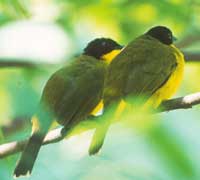 |
| Black-capped Bulbul |
Rasmussen and Anderton (in press) also state that the Sri Lankan races of the Common Hawk Cuckoo (Hierococcyx varius ciceliae) and the Eurasian Blackbird (Turdus simillima kinnisii) may well also warrant treatment as full species and would therefore be island endemics. However, they are not so treated in Rasmussen and Anderton (in press), pending further data and analyses.
Rasmussen and Anderton (in press) recognised the following species as endemic, which were not treated as endemics in Grimett et al (1999).
Pompadour Green Pigeon Treron pompadora
Serendib Scops-Owl Otus sp.
Ceylon Small Barbet Megalaima rubricapillus
Crimson-backed Flameback Chrysocolaptes stricklandi
Ceylon Swallow Hirundo hyperythra
Ceylon Woodshrike Tephrodornis affinis
Black-capped Bulbul Pycnonotus melanicterus
Ceylon Scaly Thrush Zoothera imbricata
Ceylon Scimitar-Babbler Pomatorhinus [schisticeps] melanurus
Ceylon Crested Drongo Dicrurus lophorhinus
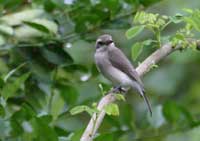 |
| Ceylon Woodshrike |
The status in the table below is per Hoffmann (1998). Pompadour Green Pigeon, Serendib Scops Owl, Crimson-backed Flameback, Ceylon Swallow, Ceylon Woodshrike and Ceylon Scimitar Babbler are not on Hoffmann's list. For these species, the author has used a threat category based on his subjective experience in the field.
Status, Distribution and Sites
Sri Lanka Spurfowl Not threatened. Wet lowlands and hills, local in dry zone. Sinharaja, Kithulgala, Kottawa.
Sri Lanka Junglefowl Not threatened. Widespread. Yala NP, Horton Plains NP, Sinharaja.
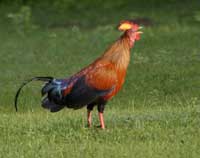 |
| Sri Lanka Junglefowl |
Sri Lanka Wood-pigeon Vulnerable. Higher hills locally descending to foothills. Horton Plains NP, Surrey Estate, Hakgala.
Pompadour Green Pigeon Not threatened. Widespread in lowlands to mid hills. Yala NP, Uda Walawe NP, Hiyare.
Sri Lanka Hanging-parrot Not threatened. Hills and adjacent lowlands. Sinharaja, Udawattakale
Layard's Parakeet Not threatened. Hilly and adjacent lowlands. Sinharaja, Udawattakele, Peak Wilderness.
Red-faced Malkoha Vulnerable. Lowlands to mid hills. Sinharaja, Kithulgala.
Green-billed Coucal Vulnerable. Wet lowlands and adjoining hills. Bodhinagala, Sinharaja.
Serendib Scops Owl Vulnerable, Wet lowlands. Sinharaja, Kanneliya, Kithulgala.
Chestnut-backed Owlet Near-Threatened. Wet lowlands and hills. Kithulgala, Sinharaja, Peak Wilderness
Sri Lanka Grey Hornbill Not threatened. Lowlands and lower hills. Bodhinagala, Kithulgala, Sinharaja, Sigiriya, Giritale.
Yellow-fronted Barbet Not threatened. Common in wet lowlands and hills.
Ceylon Small Barbet Not threatened. Only endemic found in the capital. Common in wet lowlands and lower hills. Sinharaja, Kithulgala, Kandy etc.
Crimson-backed Flameback Mainly in wet zone forests in lowlands to highlands. Occasionally in dry zone. Sinharaja, Kithulgala.
Ceylon Swallow Not threatened. Lowlands to highlands. Talangama, Yala NP, Uda Walawe NP.
Ceylon Woodshrike Not threatened. Mainly dry lowlands. Yala NP, Bundala NP.
Black-capped Bulbul Not threatened. Lowlands to mid hills. Sinharaja, Giritale, Bodhinagala
Yellow-eared Bulbul Near-Threatened. Mid and higher hills. Horton Plains NP, Hakgala, Victoria Park.
Sri Lanka Whistling Thrush Endangered. Mid and higher hills of wet zone. Horton Plains NP, Hakgala..
Spot-winged Thrush Near-Threatened. Wet zone lowlands and hills, local in dry zone. Kithulgala, Peak Wilderness.
Ceylon Scaly Thrush Vulnerable. Wet zone lowlands and highlands. Sinharaja, Horton Plains NP.
Sri Lanka Bush Warbler Near-Threatened. Higher hills. Horton Plains NP, Hakgala.
Dull-blue Flycatcher Near-Threatened. Mid to higher hills. Horton Plains, Hakgala, Knuckles.
Brown-capped Babbler Not threatened. One subspecies in wet lowlands and hills and another in the dry lowlands. Bodhinagala, Sinharaja, Uda Wattakele, Bundala, Giritale.
Ceylon Scimitar-Babbler Not threatened. Races occur thoughout the island. Sinharaja, Kithulgala, Horton Plains NP.
Orange-billed Babbler Near-Threatened. Wet lowlands and adjoining hills. Sinharaja, Kithulgala, Peak Wilderness.
Ashy-headed Laughing Thrush Vulnerable. Wet lowlands and adjoining lower hills. Sinharaja, Kithulgala.
Legge's Flowerpecker Near-Threatened. Wet lowlands and adjoining hills. Sinharaja, Peak Wilderness.
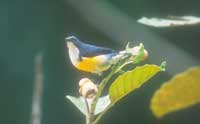 |
| Legge's Flowerpecker |
Sri Lanka White-eye Not threatened. Wet foothills to higher hills where it is common. Sinharaja, Hakgala, Horton Plains, Peak Wilderness.
Ceylon Crested Drongo Near-Threatened. Wet zone lowlands. Sinharaja, Kithulgala.
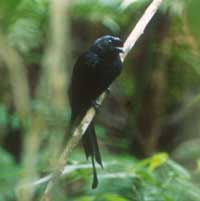 |
| Ceylon Crested Drongo |
Sri Lanka Blue-magpie Not threatened. Wet zone foothills to higher elevations. Kithulgala, Sinharaja, Peak Wilderness, Horton Plains.
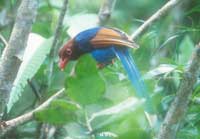 |
| Sri Lanka Blue Magpie |
White-faced Starling Vulnerable. Wet zone foothills to mid elevations. Sinharaja.
Sri Lanka Myna Near-Threatened. Hill zone. Sinharaja, Kithulgala, Knuckles.
Ceylon Hill Munia Not threatened. Wet zone lowlands and hills. Hakgala, Nuwara Eliya, Horton Plains, Sinharaja.
Bird Names
The bird names used in the text of the book generally follows the OBC checklist at species level. The exceptions are the endemics recognised by Rasmussen and Anderton (in press). In addition, to draw attention to distinctive subspecies, the names of Wijesinghe have been used in a few cases. For example, the name Grey Tit is used for Parus major mahrattarum, the local race of the Great Tit.
Further reading and references
A good handbook is G.M. Henry's A Guide to the Birds of Sri Lanka, now in its third revised and expanded edition. The third revised edition is a bit confusing as no distinction is made between 'old text' and 'new text'. More compact and identification orientated is A Field Guide to the Birds of Sri Lanka by John Harrison and Tim Worfolk, with colour plates illustrating all the species. The New Holland Photographic Guide to the Birds of Sri Lanka is a lightweight alternative for the casual birdwatcher, illustrating 252 birds with colour photographs covering the endemics and the commoner birds. See the bibliography for more books for birdwatchers. The common and Latin names in the book generally follow An Annotated Checklist of the Birds of the Oriental region by Tim Inskipp, Nigel Lindsey and William Duckworth published by the Oriental Bird Club in 1996.
References
Hoffmann, Thilo W. Threatened Birds of Sri Lanka National Red List (1008). Ceylon Bird Club, Colombo, Sri Lanka. 28 pp.
Grimmett, R., C. Inskipp, and T. Inskipp. 1999. A guide to the birds of India, Pakistan, Nepal, Bangladesh, Bhutan, Sri Lanka, and the Maldives. Princeton Univ. Press, Princeton.
Rasmussen, P. C. and J. C. Anderton. In press (expected 2004). Birds of South Asia: the Ripley guide. 2 vols. Lynx Edicions, Barcelona.
Wijesinghe, D.P. (1994) Checklist of the Birds of Sri Lanka. Ceylon Bird Club Notes Special Publication Series No. 2, Ceylon Bird Club. Colombo. 49 pp.
